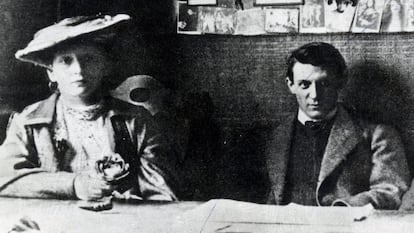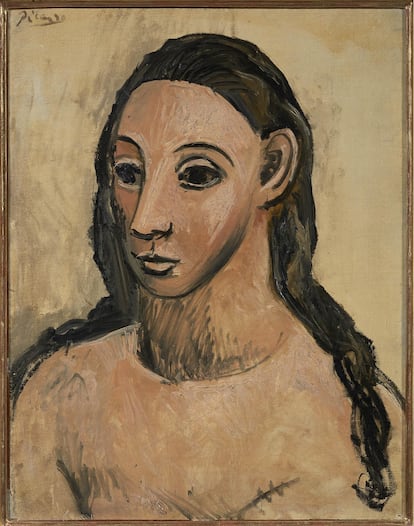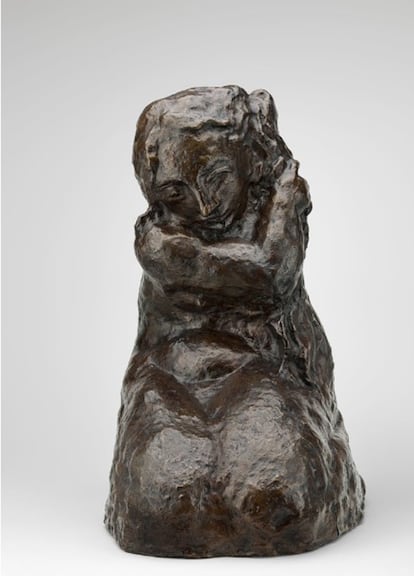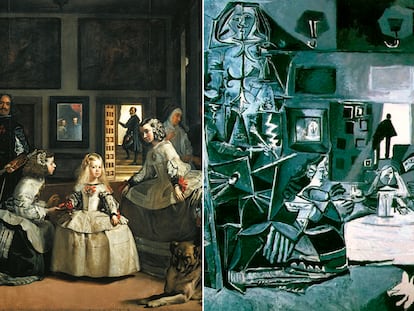Picasso’s summer of 1906: 80 days that changed the history of art
An exhibition at the Reina Sofía Museum in Madrid portrays how a trip to a small village on the Spanish side of the Pyrenees brought the famous painter out of his artistic block

Gósol is a small town in the Pyrenees mountain range, located about 93 miles from Barcelona. At an altitude of 4,668 feet, past ascending roads full of curves, it’s not easy to reach. Of course, it was far more difficult to get to Gósol in May of 1906, when Pablo Picasso decided to isolate himself for a while in the town with Fernande Olivier, the model who became the artist’s first great love. They were both 24 years old.
Accompanied by a fox terrier puppy, they made the difficult journey by cart and mule. They entered the town between May 27 and 29, probably returning to Paris on July 23. The artist ― already sought-after and respected by then ― was experiencing a creative block. His legendary speed disappeared when he was trying to photograph his friend and patron, Gertrude Stein.
Eighty days after leaving for Catalonia, when he re-entered his Parisian studio once again, he carried in his head the keys to modernity ― a path traveled by Cézanne, Manet and Matisse. Picasso resolved the portrait of Gertrude Stein by grafting a proto-cubist head onto a body of warm colors, thus creating one of the most transcendent and powerful images of the 20th century. This marked the beginning of what would be known as his “Rose Period.”
Les Demoiselles d’Avignon (1907) would soon arrive ― an enormous oil painting (8′ x 7′ 8″) that marks a before and after in art history, due to its stylistic and conceptual break with the past. Hence, the village of Gósol stars in one of the great exhibitions of the year: Picasso, 1906. The great transformation will be exhibited at Madrid’s Reina Sofia Museum between November 15, 2023 and March 4, 2024.
The Rose Period has aroused the interest of numerous researchers, although the reference book for scholars is Picasso in Gósol, 1906, by Jèssica Jaques Pi. The 56-year-old professor at the Autonomous University of Barcelona ― who has family ties to Gósol ― hasn’t stopped enriching the research available on that important Picasso period, although some questions still remain unanswered.

Before beginning the decisive trip to Gósol, Pablo Picasso was already a respected artist. His importance grew from his friendship with Gertrude Stein, which began in November of 1905. Jaques Pi explains that Stein was “a rich writer ― American, lesbian and Jewish ― who marked two moments in Picasso’s [body of work] in the first decade of the 20th century.”
“Before her,” the historian notes, “Picasso moved in the artistic circles of the most precarious bohemia of Paris, that of Montmartre (in the 18th arrondissement). Thanks to her, he moved into more select circles. Gertrude met Picasso in 1905 and invited him to her Saturday gatherings, where the artist met [Henri] Matisse and was able to see his first [work by] Cézanne, as well as other works by the artists who would precipitate the avant-garde.”
“Gertrude was a patron of many of them,” Jacques Pi continues, “and also of Picasso. Furthermore, both hybridized creative processes, since Stein’s writing has a lot to do with cubism. Picasso sold his paintings through dealers ― Vollard (first) and Kahnweiler (later) ― who were possibly the most capable of giving him the boost he needed to transcend bohemian circles and make himself into an international painter. In 1911, 1912 and 1913, his work had already been exhibited in a small gallery in New York. And, in 1912, [his paintings appeared] in two exhibitions in Berlin and Munich, which were no less important. [These exhibitions] were discreet, given that they were somewhat unusual for foreign artists (including Picasso, a Spaniard) who were trying to ‘make their way in Paris’ at the beginning of the century.”
Numerous reasons have been given as to why Picasso and his lover made a trip to such a remote place. There are those who say that he was sick with syphilis, or that he was addicted to opium. But the most credible version is that Picasso wanted his parents ― who lived in nearby Barcelona ― to meet his girlfriend, the model Fernande Olivier, before continuing on with her to that tiny, isolated town, which several Catalan friends had told him about.
Fernande Olivier, his first great love
Much is known about Picasso’s successive partners, but not so much about the woman who is considered to have been his first great adult love: Fernande Olivier. This gap in his life is something that the Picasso Museum in Barcelona will remedy next year, with an exhibition dedicated to her years as a model.
Born Amélie Lang, she changed her name to hide from her husband ― a man she abandoned because of his abuse. Jaques Pi describes Fernande as a woman of the same age as Picasso, who was taller than him. “Known as la belle Fernande,” the historian explains, “her nature was warm, witty and kind. She knew how to mix the precariousness of the bohemian life that she shared with Pablo in the Bateau-Lavoir (a building where artists lived poorly) with hedonistic details typical of the more wealthy classes, such as a passion for exotic perfumes.”
Jaques Pi points out that what made Fernande suffer the most in Gósol was not the cold of the extremely rainy summer of 1906, but rather that she was left without her favorite perfume ― Eau de Chypre ― as shown by the delicious letters she wrote to a great friend of the couple’s, the poet Guillaume Apollinaire. She tried to get him to send it to her from Paris.
Olivier was with Picasso from 1904 to 1912. She was the only woman who, in moments of precariousness ― despite already being separated from him ― claimed part of the income from the sales of works from the years they shared. This was his way of recognizing her participation in his life as a model and partner. She posed in numerous works for Picasso. Perhaps the best known are Fernande with a Black Mantilla (1905), Les Demoiselles d’Avignon (1907) and Head of Fernande (1909)
A moderate consumer of opium
Why did the couple travel to such a remote place? Did Picasso have health problems? Jaques Pi responds to the old story, which says that Picasso went to Gósol to try to quit opium, or to heal from a venereal disease. Some say he then left because of an outbreak of typhus in town. However, upon consulting the municipal archives, no one died of typhus that year, while the (few) period photos show a Picasso in good health. He did take some opium, although he didn’t consider it to be a serious addiction until the death of his friend, the painter Karl-Heinz, in 1908.
The trip was hard (eight hours by mule to access the peaks of the Pyrenees), but Picasso and Olivier didn’t give up. Jacques Pi says that the couple arrived in a landscape as sublime as it was remote, inhabited by a community immersed in an economy of strict survival, with the only resources being those of absolute necessity. They stayed at the Cal Tampanada inn ― the only one in town ― run by Josep Fondevila, a gentleman in his eighties who would have a fundamental presence in Picasso’s production until his final paintings.

The community that received Picasso and Fernande was fundamentally made up of women, given that men of working age were dedicated to itinerant trades: they were shearers, cattle dealers and nomadic shepherds. The women took care of the children, the elderly, the livestock, the houses and the little cultivation that the high mountain lands allowed. Some ― the most agile and daring ― risked their lives for the couple, carrying a bundle from the French border that was full of perfume and tobacco essence.
In Gósol, Picasso discovered a form of femininity that had nothing to do with Barcelona, Madrid or Paris. What he found was a matriarchy, which would influence his iconography of the strong woman ― a recurrent theme in his work.
The historian adds that the residents communicated in a very French-sounding form of Catalan. The children had Spanish as their school language, but it was foreign to their way of life. Picasso probably mixed both languages to integrate into the matriarchal community. He appreciated this human landscape to such an extent that he gave himself the nickname Pau de Gósol, as can be seen in documents from the time that were signed by the artist.
What kind of life did the couple lead in the village? “We can imagine,” Jacques Pi answers, “that he painted when it rained. And, when it didn’t rain, he went out to draw sketches in his carnet català ― a small notebook where he took notes and sketches. Together with Fernande, he ate at the Cal Tampanada inn and played cards. Perhaps he accompanied the smugglers ― full of excitement at the danger ― and found some fossils as he wandered along the paths between the terraced fields. He probably took more than one nap in the meadows and learned to reap the wheat, watched the couples dance on Sundays and played with his fox terrier and other village dogs, and petted the donkeys and mules. Above all, he enjoyed the friendship of two people: Josep Fondevila and a woman whom he gave the nickname Herminia. She resulted in the most iconic canvas of the ones he painted there: Woman with Loaves (Philadelphia Museum of Art), a peculiar appropriation of Da Vinci’s Mona Lisa.”

And when did the couple decide to leave the village? It seems that only they knew the real reason. Ruling out the possibility that there was any type of plague on the mountain, it’s most likely that Picasso already had the path to follow in his head. In about three months, he had finished or sketched more than 302 works. Jèssica Jaques Pi answers that “Picasso’s production in Gósol transcends the artist and contributes to the story of art history. [He offered] some of the most typical creative strategies of modernity, fundamentally three. The first: with the advent of photography, art should not (and can no longer) imitate reality, but quite the opposite; it’s reality that will imitate art. The second: the acceptance that, to learn, you have to unlearn ― that to build, you have to deconstruct. The third was the power of symbolism: artistic forms were deprived of a pre-established meaning. All of this can be seen in the long-awaited exhibition at the Reina Sofía Museum.”
Sign up for our weekly newsletter to get more English-language news coverage from EL PAÍS USA Edition
Tu suscripción se está usando en otro dispositivo
¿Quieres añadir otro usuario a tu suscripción?
Si continúas leyendo en este dispositivo, no se podrá leer en el otro.
FlechaTu suscripción se está usando en otro dispositivo y solo puedes acceder a EL PAÍS desde un dispositivo a la vez.
Si quieres compartir tu cuenta, cambia tu suscripción a la modalidad Premium, así podrás añadir otro usuario. Cada uno accederá con su propia cuenta de email, lo que os permitirá personalizar vuestra experiencia en EL PAÍS.
¿Tienes una suscripción de empresa? Accede aquí para contratar más cuentas.
En el caso de no saber quién está usando tu cuenta, te recomendamos cambiar tu contraseña aquí.
Si decides continuar compartiendo tu cuenta, este mensaje se mostrará en tu dispositivo y en el de la otra persona que está usando tu cuenta de forma indefinida, afectando a tu experiencia de lectura. Puedes consultar aquí los términos y condiciones de la suscripción digital.
More information
Archived In
Últimas noticias
Most viewed
- Sinaloa Cartel war is taking its toll on Los Chapitos
- Oona Chaplin: ‘I told James Cameron that I was living in a treehouse and starting a permaculture project with a friend’
- Reinhard Genzel, Nobel laureate in physics: ‘One-minute videos will never give you the truth’
- Why the price of coffee has skyrocketed: from Brazilian plantations to specialty coffee houses
- Silver prices are going crazy: This is what’s fueling the rally









































